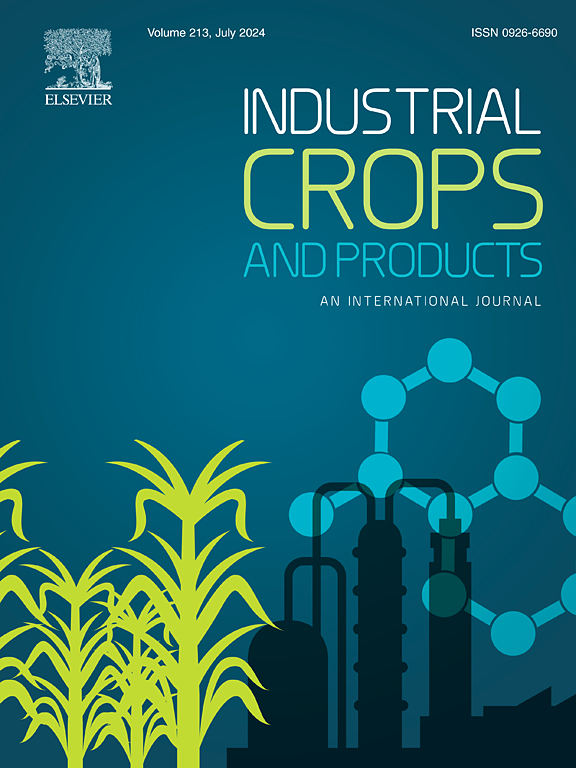尼日尔(Guizotia abyssinica L.F.Cass)种质的表型特征及其核心种质选择
IF 5.6
1区 农林科学
Q1 AGRICULTURAL ENGINEERING
引用次数: 0
摘要
尼日尔(Guizotia abyssinica)是重要的工业油料作物。本研究以印度国家基因库中保存的2850份油菜为研究对象,对其农业形态特征和总含油量进行了分析。通过扩增块设计,在冬季(2021-2022年)4个不同地理位置对扩增材料的19个农业形态性状(包括13个数量性状和6个质量性状)和4个检验品种进行了评价。基于平均遗传距离的标准优化后,利用R中的core Hunter编译农业形态性状数据(标准化以消除尺度差异),开发了5个独立的核心集。核心大小强度固定为300个条目,约占整个集合大小的10% %。其中,基于方差差100 %、符合率97.84 %、变异系数变化率135.16 %、均值差46.15 %等评价指标,选择核心集EN100作为最佳代表。使用R软件包EvaluateCore评估开发的核心集合的最大多样性表示。多样性指数Shannon-Weiner(1.014)、McIntosh(0.26)和较低的Simpson 's指数(0.57)表明所选核心具有较高的多样性。研究结果表明,核心集合中所有性状的变异系数高于整个集合,并且大多数性状在核心集合中的分布是对称的,这表明核心集合有效地代表了整个集合中存在的变异性。前5个主成分对核心集EN100累积方差的贡献率为66.15% %,对整个集的贡献率为64.5% %,其中PC1和PC2的贡献率分别为21.6% %和14.5 %。这一高度多样化的代表性核心集EN100可用于有效地识别具有工业重要性的理想农艺性状的材料。本文章由计算机程序翻译,如有差异,请以英文原文为准。
Phenotypic characterisation of niger (Guizotia abyssinica L.F.Cass) germplasm for selection of core collection
Niger (Guizotia abyssinica) is an important industrial oil seed crop. In the present study, a total of 2850 accessions conserved in the Indian National Gene Bank, representing India and other parts of the world, were characterized for their agro-morphological traits and total oil content. The augmented accessions were evaluated for 19 agro-morphological traits, including 13 quantitative and six qualitative traits, along with four check varieties at four different geographical locations in the winter season (2021–2022) through an Augmented Block Design. Five independent core sets were developed using compiled data on agro-morphological traits (standardized to eliminate scale differences) with Core Hunter in R, following optimization of average genetic distance-based criteria. Core size intensity was fixed at 300 accessions, which is approximately 10 % of the size of entire collection. Among the five, the core set EN100 was selected as the best representation based on the evaluation indices like, variance difference of 100 %, coincidence rate of 97.84 %, variable rate of coefficient of variation at 135.16 %, and mean difference at 46.15 %. The developed core collection was evaluated for its maximum diversity representation using the R package EvaluateCore. Diversity indices, Shannon-Weiner (1.014), McIntosh (0.26), and a lower Simpson’s Index (0.57) indicated high diversity in the selected core. The findings, such as a higher coefficient of variation for all traits in the core set than in the entire collection and a symmetrical distribution of accessions across the core set for the majority of traits, showed that the core collection effectively represents the variability present in the entire collection. and the first five principal components explained 66.15 % of cumulative variance in core set EN100, whereas 64.5 % in entire collection, with PC1 and PC2 contributing 21.6 % and 14.5 %, respectively. This highly diverse representative core set EN100 could be used to effectively identify accessions with desirable agronomic traits of industrial importance.
求助全文
通过发布文献求助,成功后即可免费获取论文全文。
去求助
来源期刊

Industrial Crops and Products
农林科学-农业工程
CiteScore
9.50
自引率
8.50%
发文量
1518
审稿时长
43 days
期刊介绍:
Industrial Crops and Products is an International Journal publishing academic and industrial research on industrial (defined as non-food/non-feed) crops and products. Papers concern both crop-oriented and bio-based materials from crops-oriented research, and should be of interest to an international audience, hypothesis driven, and where comparisons are made statistics performed.
 求助内容:
求助内容: 应助结果提醒方式:
应助结果提醒方式:


